Navigation
Install the app
How to install the app on iOS
Follow along with the video below to see how to install our site as a web app on your home screen.
Note: This feature may not be available in some browsers.
More options
Style variation
-
Congratulations MintJulep on being selected by the Eng-Tips community for having the most helpful posts in the forums last week. Way to Go!
You are using an out of date browser. It may not display this or other websites correctly.
You should upgrade or use an alternative browser.
You should upgrade or use an alternative browser.
Reason for Subdivison 1
- Thread starter Mbrooke
- Start date
- Status
- Not open for further replies.
- Thread starter
- #3
Understood, but the article simply says code stipulates mechanical protection of any circuit necessary in life safety. It also reasons seperation;
which I fully agree with but can also be fulfilled by having two separate generator backed systems both mechanically protected and completely independent of one another. The article does not say why there must be separate ATSs.
Section 517.30(C)(1) requires separation of the emergency circuit wiring from the normal circuits. This is to reduce possibilities of a failure in a normal circuit causing the failure of an emergency circuit.
which I fully agree with but can also be fulfilled by having two separate generator backed systems both mechanically protected and completely independent of one another. The article does not say why there must be separate ATSs.
- Moderator
- #4
I have more than once seen situations where an overloaded generator caused the destruction of an ATS in minutes.
You don't want a fault on the normal system to take out a life safety ATS.
A fire may compromise a normal duty feeder and damage the ATS. You want the life safety ATS to be independent.
Bill
--------------------
"Why not the best?"
Jimmy Carter
You don't want a fault on the normal system to take out a life safety ATS.
A fire may compromise a normal duty feeder and damage the ATS. You want the life safety ATS to be independent.
Bill
--------------------
"Why not the best?"
Jimmy Carter
- Thread starter
- #6
waross said:I have more than once seen situations where an overloaded generator caused the destruction of an ATS in minutes.
Can you elaborate more on this? I can't see an overload generator effecting an ATS. Damage to the engine or alternator, yes.
You don't want a fault on the normal system to take out a life safety ATS.
The ATS should have OCPD protection before it on both sides so a fault does not destroy it.
A fire may compromise a normal duty feeder and damage the ATS. You want the life safety ATS to be independent.
Sure- and I would think same protection is afforded by having two systems separated from one another.
-
1
- Moderator
- #7
The overload slowed the generator down.
The transfer switch dropped out, drawing heavy current across the contacts.
The generator recovered.
The transfer switch dropped out, drawing heavy current across the contacts.
The generator recovered.
Repeat.
While the current was well within the breaking capacity of the ATS and below the capacity of the generator breaker, the repeated breaking without an adequate cool down time melted the contacts.
The cycle eventually stopped when there was no longer enough of the contacts left to make contact.
I have installed a lot of transfer switches and have never seen one with self protection.
The transfer switch should be sized to be adequately protected by the mains protection or by the generator protection already in place.
Closing a common transfer switch into a faulted feeder may impair the reliability of the critical system.
Suppose the faulted feeder trips the generator breaker, or the common protection that you suggest.
"The ATS should have OCPD protection before it on both sides so a fault does not destroy it."
Bill
--------------------
"Why not the best?"
Jimmy Carter
The transfer switch dropped out, drawing heavy current across the contacts.
The generator recovered.
The transfer switch dropped out, drawing heavy current across the contacts.
The generator recovered.
Repeat.
While the current was well within the breaking capacity of the ATS and below the capacity of the generator breaker, the repeated breaking without an adequate cool down time melted the contacts.
The cycle eventually stopped when there was no longer enough of the contacts left to make contact.
I have installed a lot of transfer switches and have never seen one with self protection.
The transfer switch should be sized to be adequately protected by the mains protection or by the generator protection already in place.
Yes. The transfer switch is part of the separated system.Mbrooke said:Sure- and I would think same protection is afforded by having two systems separated from one another.
Closing a common transfer switch into a faulted feeder may impair the reliability of the critical system.
Suppose the faulted feeder trips the generator breaker, or the common protection that you suggest.
"The ATS should have OCPD protection before it on both sides so a fault does not destroy it."
Bill
--------------------
"Why not the best?"
Jimmy Carter
- Thread starter
- #8
The overload slowed the generator down.
The transfer switch dropped out, drawing heavy current across the contacts.
The generator recovered.
The transfer switch dropped out, drawing heavy current across the contacts.
The generator recovered.
Repeat.
Was this a contactor ATS? I know those will drop out on voltage, pullout, voltage regains and then pull back in. I can't see it happening with a UL single pole double throw ATS. At least not if utility power is completely dead on all phases.
While the current was well within the breaking capacity of the ATS and below the capacity of the generator breaker, the repeated breaking without an adequate cool down time melted the contacts.
The cycle eventually stopped when there was no longer enough of the contacts left to make contact.
This can happen even in a subdivided system. Picture this happening during a power outage with a critical branch ATS. Eventually the critical branch will fail completely leaving the ERs, ICU, NICU and ORs without any power power. Those vanilla receptacles on the normal branch will be of no benefit.
I have installed a lot of transfer switches and have never seen one with self protection.
The transfer switch should be sized to be adequately protected by the mains protection or by the generator protection already in place.
Yup- sizing correctly and having the right protection with selective coordination is key. As well as having more than one backed up system to critical areas- but doing so could actually violate code...
- Thread starter
- #9
Here is an example of what I have in mind >>>
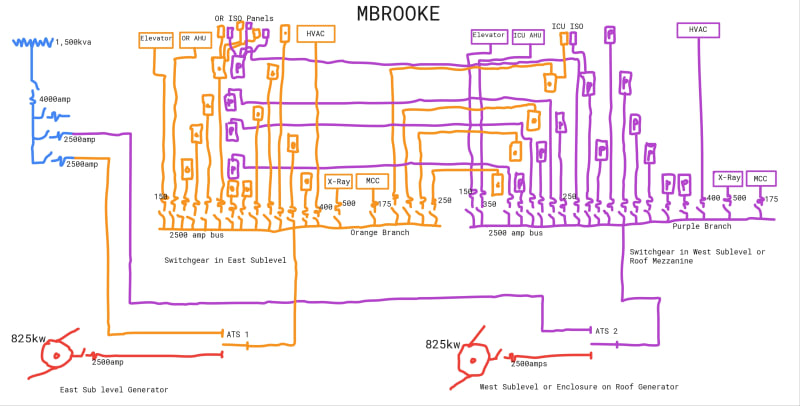
VS
This:
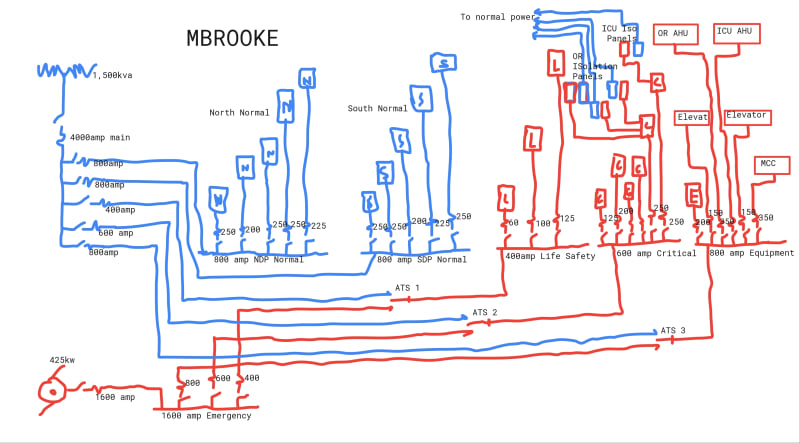
The prior stems from the practice that it is becoming more and more common to backup everything in hospitals. If two independent branches exists with independent ATSs and backup sources, why would code mandate a separate critical and life safety branches when arguably drawing number one provides that same level if not better redundancy?
Ie, in separate Life Safety, Critical and Equipment branches require that the generator have its own dedicated switchboard instead of directly feeding into a single ATS.

VS
This:

The prior stems from the practice that it is becoming more and more common to backup everything in hospitals. If two independent branches exists with independent ATSs and backup sources, why would code mandate a separate critical and life safety branches when arguably drawing number one provides that same level if not better redundancy?
Ie, in separate Life Safety, Critical and Equipment branches require that the generator have its own dedicated switchboard instead of directly feeding into a single ATS.
- Thread starter
- #10
Time and time again I'm seeing this in hospitals- feeding everything through parallel gear:

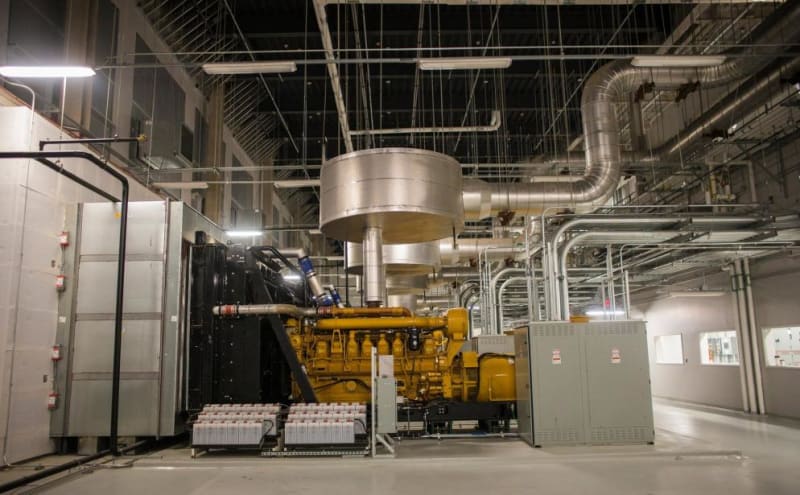
I want to take the same and run it into individual gear/ATSs dedicated to one genset like this:
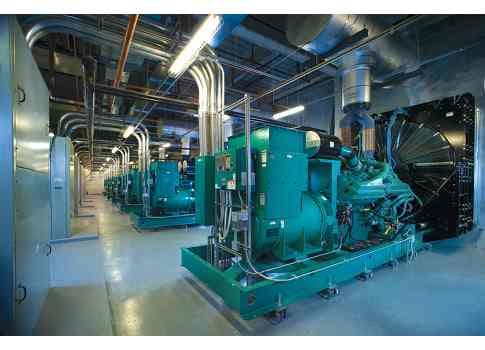
So having 6-12 separate systems.
The case made for full power and paralleling:
Given that:
1) The essential system today typically cares 50% to 60% of a facility's power;
2) X-rays go up after major storm events;
3) Need for Air conditioning and heating- 2003 blackout led to countless heat stroke cases going to ERs without ACs.
4) Power outages tend to last longer, if not a week (or more) due to climate change
For this reason hospitals are now starting to apply 100% backup power. The typical default is paralleled gen-sets in same room via a comprehensive gear package ($$$$). Critical areas have some level of N-1 at best. Still bound to old design and "fire centric" code.
I am lead to ponder if the same number of sets can stand alone- in theory giving true N-7 (8x) or what have you for critical.
Bear in mind the most comprehensive data centers are 3x at best at their servers.
Quoted from:
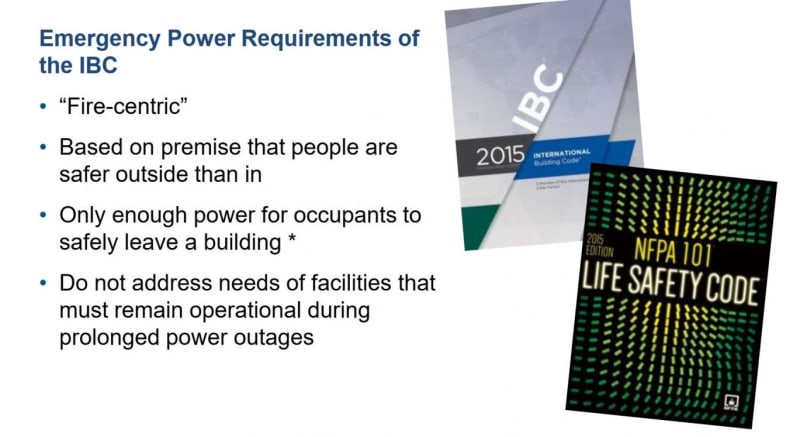
Page 5 onward:


I want to take the same and run it into individual gear/ATSs dedicated to one genset like this:

So having 6-12 separate systems.
The case made for full power and paralleling:
the life safety branch .... these loads would include a very small percentage of a hospital’s total electrical system, typically 5% to 10% at most
Where life safety power would only be 5% of the building’s power requirement, the critical power system of a hospital could easily account for 25% or more of a hospital’s total power requirement.
The equipment system can easily account for 30% or more of the overall hospital electrical system.
In summary, the total amount of emergency power for most buildings (and therefore the amount of emergency distribution equipment needed) is typically 10% or less and consists of only that minimal amount of power needed to help people safely exit a building within the first few minutes of normal power interruption. For hospitals, emergency power becomes the life blood of a building without utility power and must be maintained throughout a power outage, which could last for days after a storm or other catastrophic event. As a result, it’s not unusual to see the emergency power of a hospital exceed 50% or 60% of the building’s total power needs. Also, as separate transfer switches are need for each type of load (life safety, critical, nondelayed automatic equipment, delayed automatic equipment, and delayed automatic or manual connection equipment loads), multiple ATSs are always needed for hospitals. For a 200,000-sq-ft hospital, eight or more transfer switches could be used. A similarly sized office building would typically have only two ATSs.
Given that:
1) The essential system today typically cares 50% to 60% of a facility's power;
2) X-rays go up after major storm events;
3) Need for Air conditioning and heating- 2003 blackout led to countless heat stroke cases going to ERs without ACs.
4) Power outages tend to last longer, if not a week (or more) due to climate change
For this reason hospitals are now starting to apply 100% backup power. The typical default is paralleled gen-sets in same room via a comprehensive gear package ($$$$). Critical areas have some level of N-1 at best. Still bound to old design and "fire centric" code.
I am lead to ponder if the same number of sets can stand alone- in theory giving true N-7 (8x) or what have you for critical.
Bear in mind the most comprehensive data centers are 3x at best at their servers.
Quoted from:

Page 5 onward:
- Moderator
- #11
I'm not sure if this will help:
Canadian Electrical Code, 2015
It appears that one generator may be used.
However vital systems must have power restored within 10 seconds.
You may need a dedicated generator to meet the 10 second rule.
Vital systems must have an automatic transfer switch that is:
Electrically operated.
Mechanically held.
Capable of being manually operated.
Non-vital systems may be switched with a manual transfer switch.
With multiple generators, you may not be able to stabilize and parallel the sets in time to meet the 10 second rule.
Bill
--------------------
"Why not the best?"
Jimmy Carter
Canadian Electrical Code, 2015
It appears that one generator may be used.
However vital systems must have power restored within 10 seconds.
You may need a dedicated generator to meet the 10 second rule.
Vital systems must have an automatic transfer switch that is:
Electrically operated.
Mechanically held.
Capable of being manually operated.
Non-vital systems may be switched with a manual transfer switch.
CEC 2015 said:Vital branch — the portion of an essential electrical system in which the circuits require power restoration
within 10 s.
I don't see anything in the Canadian code to prevent one generator and one transfer switch for a small hospital.CEC 2015 said:24-304 Transfer switches (see Appendix B)
(1) All transfer switches shall comply with the requirements of the supply authority.
(2) Automatic transfer switches used in essential electrical systems shall conform to the requirements of
CSA C22.2 No. 178.1 and, in addition, shall
(a) be electrically operated and mechanically held; and
(b) include means for safe manual operation.
(3) Manual transfer switches shall conform to the following:
(a) the switching means shall be mechanically held and the operation shall be by direct manual control
or by electrical remote manual control utilizing control power from the supply to which the load is
being transferred;
(b) a manual transfer switch that is operated by electrical remote manual control shall include a means
for safe manual mechanical operation;
(c) reliable mechanical interlocking (and, in the case of a switch operated by electrical remote manual
control, electrical interlocking) to prevent interconnection of the normal and the emergency supplies
of power shall be inherent in the design of a manual transfer switch; and
(d) a manual transfer switch shall include a readily visible mechanical indicator showing the switch
position.
(4) The vital and delayed vital branches shall be connected to the emergency power supply by means of one
or more automatic transfer switches.
(5) The conditional branch shall be connected to the emergency power supply by either a manual or an
automatic transfer switch.
With multiple generators, you may not be able to stabilize and parallel the sets in time to meet the 10 second rule.
Bill
--------------------
"Why not the best?"
Jimmy Carter
If you don't already have it, the NEC Handbook published by NFPA is a great starting point for interpretation of the NEC articles as well as background on why changes were made and some great illustrations. At the end of the day, you will want to have your design reviewed by AHJ prior to any equipment purchase or construction. I've seen some interesting interpretations of NEC requirements for hospitals by local AHJ. Some real head-scratchers.
- Thread starter
- #13
- Thread starter
- #14
I've seen some interesting interpretations of NEC requirements for hospitals by local AHJ. Some real head-scratchers.
Do you have examples?
I came up with a design that is actually better, cheaper, ect but at the same time violates code in that there aren't 3 essential branches.
Instead 4-6 backed up branches with hospital load evenly divided among them. Critical care areas take circuits from all of these 4-6 branches. IE, a patient head-well such as this is supplied by 4 to 6 different systems without any common mode failure points.
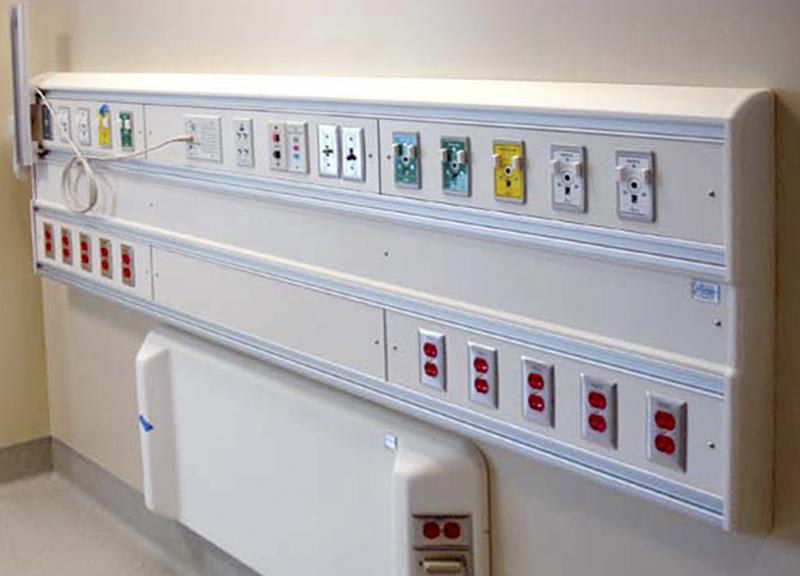
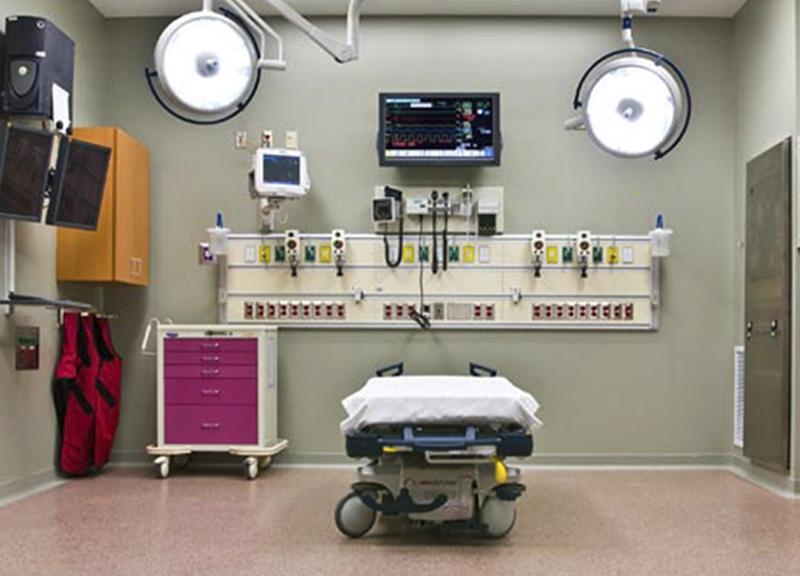
Where as typically a you find this where the red outlets are fed from one ATS and critical branch and the white outlets from a normal branch.

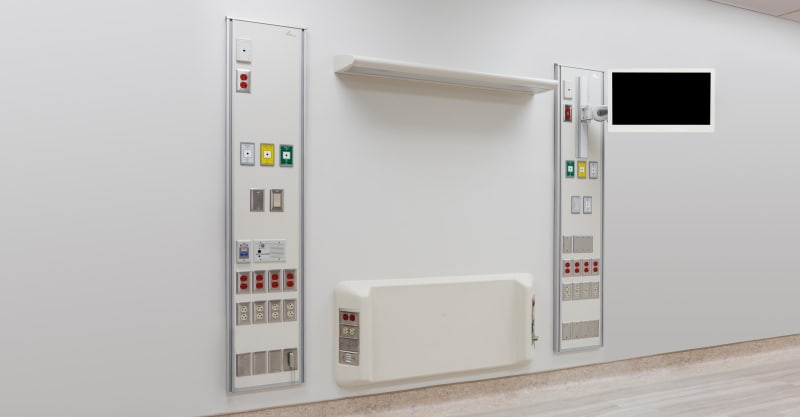
- Thread starter
- #16
I still don't know the reasoning for the 3 branches. 1971 is the first NEC that mandates subdivion but can't find the ROPs.
I don't know where it comes from, but people seem to get uncomfortable when the NEC is questioned or critiqued. Not that I have to follow it...
I don't know where it comes from, but people seem to get uncomfortable when the NEC is questioned or critiqued. Not that I have to follow it...
- Status
- Not open for further replies.
Similar threads
- Question
- Replies
- 4
- Views
- 19K
- Question
- Replies
- 3
- Views
- 4K
- Question
- Replies
- 9
- Views
- 24K
- Question
- Replies
- 5
- Views
- 12K
